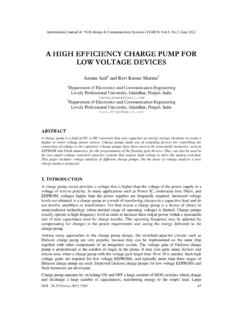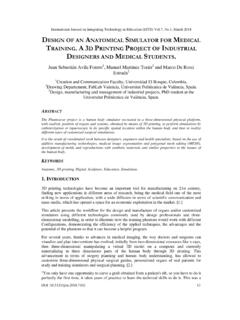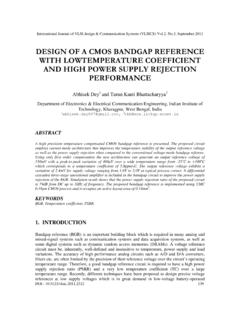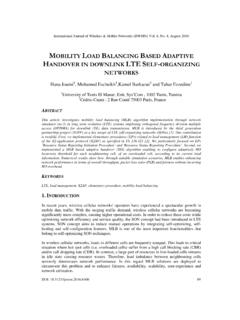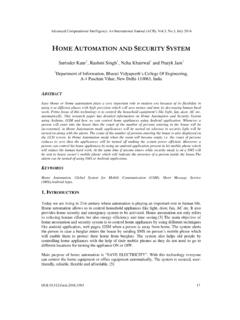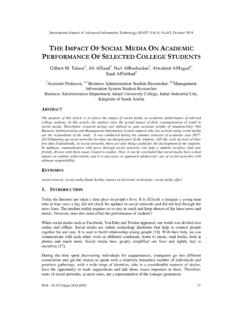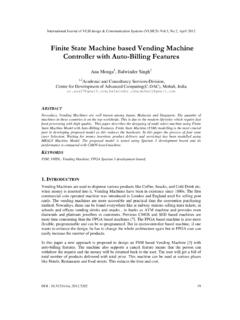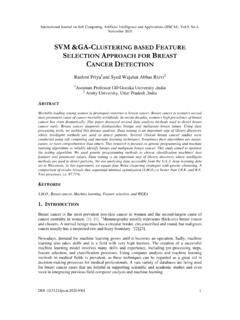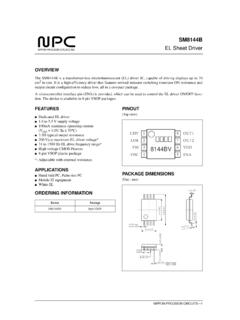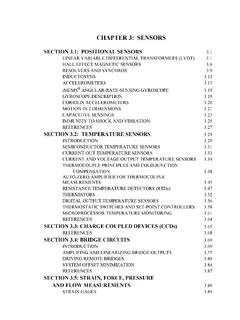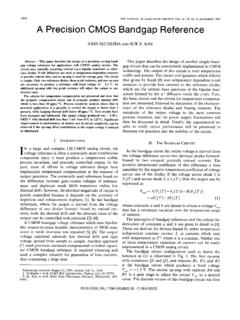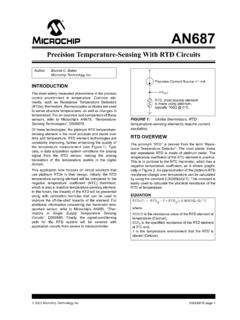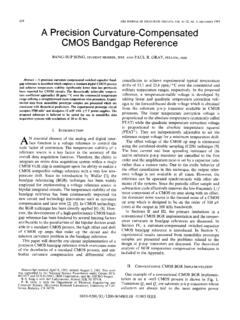Transcription of TOWARDS TEMPERATURE -INSENSITIVE …
1 International Journal of VLSI design & Communication Systems (VLSICS) , , June 2017 DOI : 1 TOWARDS TEMPERATURE -INSENSITIVE NANOSCALE CMOS CIRCUITS WITH ADAPTIVELY REGULATED VOLTAGE POWER SUPPLIES Ming Zhu1, Yingtao Jiang1, Mei Yang1, Xiaohang Wang2 1 Department of Electrical and Computer Engineering University of Nevada Las Vegas, Las Vegas, NVUSA 89154 2 School of Software, South China University of Technology, Guangzhou.
2 China ABSTRACT In this paper, we show that the TEMPERATURE -induced performance drop seen in nanoscale CMOS circuitscan be tackled by powering the circuits with adaptively regulated voltage power supplies. Essentially, when TEMPERATURE rises, the supply voltage will be bumped up to offset otherwise performance degradation. To avoid thermal over-drift as chip TEMPERATURE exceeds its operation range, a voltage limiteris integrated into the proposed power supply to cap the supply voltage. Using this proposed adaptive voltage source to power individual CMOS logic gates and/or subsystems will free the chips from using expensive high- precision TEMPERATURE sensors for thermal management and performance tuning.
3 Experiments on various benchmark circuits, which are implemented with a 45nm CMOS technology, have confirmed that the circuit delay variation can be reduced to 15%~30% over a wide TEMPERATURE range (0 C to 90 C), a sharp contrast to the large delay variations(50%~75%)observed in most IC designs where a constant power supply is employed. KEYWORDS High performance VLSI circuits; TEMPERATURE -INSENSITIVE ; voltage control; power supply. 1. INTRODUCTION Variations in power supply voltages ( ) and temperatures (T) have strong implications on the delay of a CMOS circuit , and even may cause the chip to fail.
4 In general, as chip TEMPERATURE rises, two effects are observed: (i) the descending mobility of the transistor carriers, which contributes to the increase of the circuit propagation delay, and (ii) the decreasing of the absolute value of the threshold voltage ( )of a transistor, which leads to a better delay performance. Experiments show that when both thermal effects come into play, the delay of a circuit operating at 90oCcould be twice of that at 0oC. Moreover, such sheer thermal-induced delay performance penalty can vary significantly from one chip area to another [1], due to the imbalanced utilization and diversity of circuitry at different sections.
5 As a result, ensuring the performance resilience against a wide range of TEMPERATURE variations has become one of the greatest challenges facing nano scale VLSI circuit designs[2], One most effective way to combat this TEMPERATURE -induced delays is by changing the of the circuits. Along this line, two different approach shave been considered in the literature. The first approach is based on the fact that if is pulled up, it can offset the circuit delay introduced by International Journal of VLSI design & Communicat the rise of TEMPERATURE .
6 Such approach require(LUT)[4], to alter the according to the readings from the chip. By doing so, delay variations 20% as the chip( technologies) work in[6] harnessed PVT sensors each region had its own that could designs [4]-[6] is that they require high precision TEMPERATURE sensors and abundant power control circuits, which are not easy to com Another approach to deal with the circuit at the zero- TEMPERATURE -coefficient (ZTC) voltagethermal effects on the carrier mobility and MOSFET threshold are approximately and thus, performance variations range, from 25 C to 125 Cin [2].
7 Unfortunately, this ZTC voltage is usually close to the threshold voltage of MOSFETs, which can be problematic toapproach is more suitable for low power In what follows, we will examine the temperaturein Section 2, through theoretical analysis anduse of an adaptive power supply TEMPERATURE (CTAT) current source shown in to a first order approximation, can be used to subsystems. In addition, a voltage output voltage after the TEMPERATURE logic circuits experience much smaller(Section 4), but no high- precision TEMPERATURE sensorsdrawn in Section 5.
8 2. DELAY OF BASIC CMOS VOLTAGE Principally, all primitive CMOS same delay performance. Without loss of generality, inverter (Figure 1),related to the time spent on charging or discharging its capacitive load can be expressed as: 1: Gate delay model of International Journal of VLSI design & Communication Systems (VLSICS) , , Juneapproach requires the use of a power manager, with a lookaccording to the readings from the embedded TEMPERATURE sensors, delay variations of primary Boolean logic gates could be confined technologies) TEMPERATURE varies from 0 C to 90 C[5].
9 Furthermore, tPVT sensors in multiple voltage and frequency domains of the chipcould be adjusted individually. One big downside require high precision TEMPERATURE sensors and abundant power control to come by. approach to deal with the TEMPERATURE -induced delay variations is through poweringcoefficient (ZTC) voltage level [2][7]. Essentially, by doing so, carrier mobility and MOSFET threshold are approximately canceled outvariations of the logic circuits could be negligible over a wide . Unfortunately, this ZTC voltage is usually close to the threshold can be problematic to high speed circuit designs.
10 Low power, but less performance-critical applications. In what follows, we will examine the TEMPERATURE -delay relationship of basic CMOS logic gates through theoretical analysis and circuit simulations. Such relationship as detailed in Section light of a complementary to absolute TEMPERATURE (CTAT) current source shown in [8][9], the proposed adaptive power supply source, rder approximation, can be used to build TEMPERATURE -INSENSITIVE logic circuits and In addition, a voltage limiter is integrated into the proposed power sourceafter the TEMPERATURE rises above a certain point.
